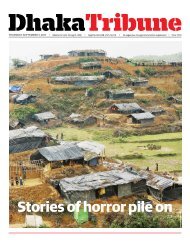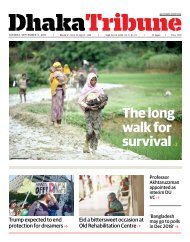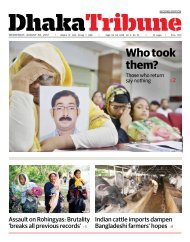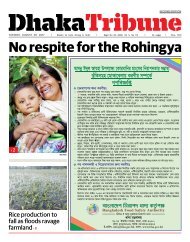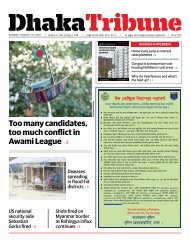e_Paper, Monday, May 15, 2017
You also want an ePaper? Increase the reach of your titles
YUMPU automatically turns print PDFs into web optimized ePapers that Google loves.
News 3<br />
MONDAY, MAY <strong>15</strong>, <strong>2017</strong><br />
DT<br />
Bangladesh<br />
basin in northeast<br />
with sand and stone chips that day,”<br />
said 46-year-old local Rokon Uddin,<br />
who witnessed the landslide.<br />
More than 2,000 acres of agricultural<br />
land in three villages<br />
– Chanpur, Rojoni Line and Rajai<br />
– owned by local farmers and villagers,<br />
disappeared in that single<br />
event which changed the area’s<br />
ecosystem and robbed thousands<br />
of their livelihoods.<br />
Since then, unplanned mining<br />
in Meghalaya – one of India’s main<br />
source of mineral resources – have<br />
been pouring large amounts of sand<br />
into the water that eventually flows<br />
into Bangladesh and ruins large areas<br />
of arable land every monsoon.<br />
Mass deforestation, caused by unplanned<br />
mining, has also caused<br />
the soil in the hills to become more<br />
vulnerable to landslides.<br />
Ponchashol Haor, which locals<br />
said used to cover a large area near<br />
Chanpur village, has now vanished<br />
because of sand intrusion from the<br />
West Khasi Hills.<br />
Complaints made earlier<br />
In 2009, the Ministry of Environment<br />
and Forest in Bangladesh<br />
sent a formal letter to the Indian<br />
High Commission in Dhaka to inform<br />
them of the issue.<br />
However, the issue appears to<br />
have been forgotten on both sides.<br />
On a recent visit to Meghalaya,<br />
this correspondent met an additional<br />
chief secretary of Meghalaya<br />
government and also in charge of<br />
mining department, who admitted<br />
that he was aware of the issue.<br />
“All good and bad things go to<br />
Bangladesh. Water runs from upstream<br />
to downstream,” he said,<br />
smiling.<br />
“Just like our river water goes<br />
down, the sediment goes down and<br />
Sand from West Khasi Hill in Meghalaya has left a vast tract of arable land in Taherpur in Sunamganj barren<br />
makes the downstream land fertile.<br />
Now the sand goes down with water<br />
and makes the land barren,” he said.<br />
Professor Ainun Nishat expressed<br />
the need for a joint watershed management<br />
for the entire region so that<br />
the problems can be managed.<br />
Prof HJ Syiemleih similarly said<br />
that the two sides need to work together<br />
to find the way to stop this<br />
sand intrusion.<br />
“India needs the mining and<br />
Bangladesh needs to be safe from<br />
sand intrusion,” he said.<br />
ABU SIDDIQUE<br />
Prof Nishat also said that Bangladesh<br />
government needed to introduce<br />
some initiatives, including<br />
dredging the water-bodies and<br />
heightening the crop protection<br />
embankments to reduce the loss of<br />
crops in the Haor basins. •<br />
17 TH MAY<strong>2017</strong><br />
T H E IN TE RN AT IONA L<br />
D E NIM EX HI B I T I O N








